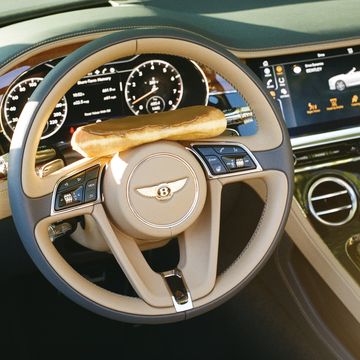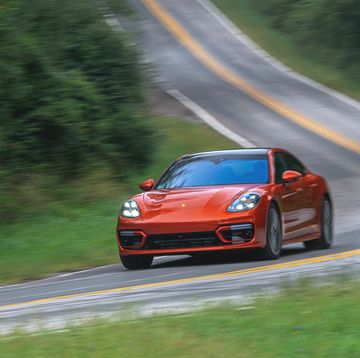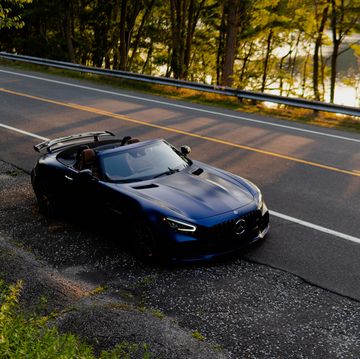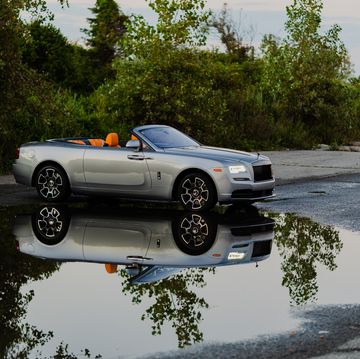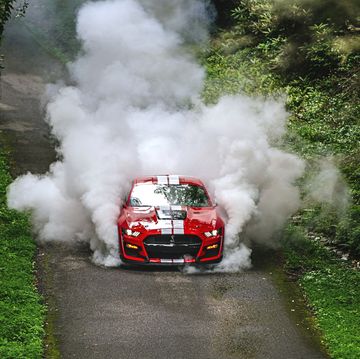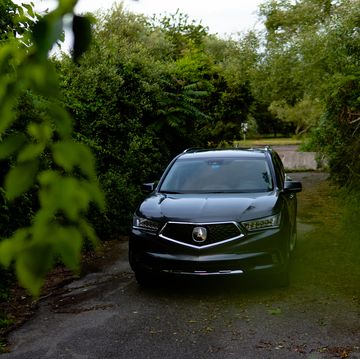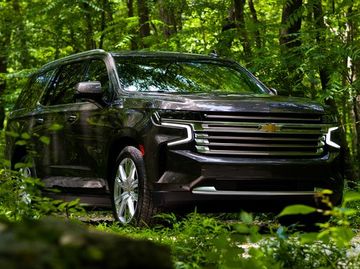I arrived in Maranello the day after Ferrari scored its first Formula 1 win in two years. It was also the team's first victory with Sebastian Vettel, the driver the Scuderia hopes is the next Michael Schumacher. The entire town was riding the high on that Monday morning in late March, with Ferrari flags hanging everywhere. Even my airport shuttle driver was in the spirit. Speeding past Dino Ferrari High School, he smiled broadly and promised to gain back the 10 hours I'd lost while delayed at the airport.
At the end of a busy side street, gates opened and the shuttle van entered the grounds of Pista di Fiorano, Ferrari's test track. I was whisked into an old three-story house, white stucco with red shutters, mere feet from the Fiorano curbing. We went up narrow stairs to a room with a low, timbered ceiling directly over hallowed ground: Enzo Ferrari's office, perfectly preserved since his death in 1988. The floor above us contained a small apartment where Schumacher and other drivers stayed before regulations curtailed Formula 1 testing at Fiorano. Today, singer Sammy Hagar, the "I Can't Drive 55" guy and serial Ferrari owner, uses it, as do other favored clienti. Every Ferrari we've ever loved has roots in this structure, which makes it as much a shrine as the Vatican. Today, two engineers are delivering a sermon on the technical details of the LaFerrari.
This is not a new car. Ferrari's 949-hp hypercar debuted at the 2013 Geneva auto show, and R&T contributor Chris Harris drove it for last year's Supercar Issue [August 2014]. Until now, though, no outsiders have been allowed to hook up a VBOX and collect data. Ferrari tightly controls testing of all its cars, and it was especially protective of the LaFerrari. Once testing is conducted, performance becomes fact, part of the historic record. And Ferrari is very shrewd with its history. Editor-at-large Sam Smith says that when you walk into the Fiorano compound, you feel all the things Ferrari wants you to feel. Only a monk wouldn't. But with the $1.3 million LaFerrari, I learned that stagecraft is superfluous. The car is incredible.
That begins with the main structure, a carbon-fiber passenger compartment formed from four different grades of cloth, hand-laid into molds and baked in Maranello's F1 facility. The engine is a 6.3-liter V12. It revs to 9250 rpm and puts out 788 hp, among the highest horsepower per liter of any non-turbo production piston engine ever. The engine sits lengthwise behind the occupants, followed by a seven-speed dual-clutch automatic transmission and then a 161-hp electric motor.
It's easy to see hybrid supercars as a fad, a must-have trinket for wealthy collectors. (All 499 LaFerraris—only 120 will come stateside—were snapped up before the first one was even finished.) Yet Ferrari engineers are adamant that electric propulsion was added solely to make the LaFerrari quicker. The electric motor fills in where the engine is soft, which allowed the engineers to tune the V12 for greater peak power. In addition, the motor also reduces response from the accelerator by a tenth of a second. The lithium-ion batteries, pancaked under the floor to lower the center of gravity, store 2.3 kilowatt-hours of energy. More batteries would have further improved fuel economy, which is already 75 percent better (EPA combined figure) than the 2003 Ferrari Enzo's, but the added weight would have hurt performance.
Unlike the Porsche 918 Spyder, which uses four-wheel drive to harness all of its 887 hp, the LaFerrari is rear-drive. All of the energy harvesting is done at the rear axle, under braking. That's an awful lot, even for 345-section rear tires to handle.
Front and rear aerodynamic devices constantly move to balance drag and downforce—a claimed 800 total pounds at 120 mph. Infinitely adjustable magnetorheological dampers keep the tires on the tarmac, and the adjustable stability control protects the sloppy and foolish without compromising the skilled.
The LaFerrari can run six laps of Fiorano in Race mode, which exploits all of its electric boost. (After the relatively small battery pack is depleted, the car switches into a long-run mode; this maintains battery charge and only reduces lap times by about a second.)
In the LaFerrari, factory test driver Raffaele de Simone laps Fiorano in one minute, 20 seconds, five seconds quicker than in the Enzo. The factory hotshoe is a tough act to follow, and as I was getting strapped in for my first lap, a helicopter flew overhead and landed nearby. Sergio Marchionne, Fiat Chrysler Automobiles CEO, strolled up unannounced. The engineers and mechanics stiffened. Marchionne, dressed in his usual dark sweater, crowed about the race win and smiled at the car. He told me not to wreck it and ambled off.
So warned, I slid into the thin shell of a seat. It's molded into the tub to avoid the weight and flex of a frame and to keep the center of gravity low. Since the seat doesn't move, the pedals are adjustable. Each owner gets custom-fitted padding. It's a bare cabin, with exposed carbon fiber and a racing-style, squared-off steering wheel.
I pressed the starter button, lighting off the V12. A flock of birds evacuated a nearby tree. The LaFerrari, however, was surprisingly docile at low speeds. It chugged along, wafting on the electric assist as I slowly increased my pace around the small and tight Fiorano circuit. By the fourth lap, the tires felt far grippier than in the initial few turns. So, after the tight, left-hand hairpin, I stopped at the beginning of the half-mile-long straight.
What happened next is cloudy. Launch mode (stability control off, hold the brake, press the launch button, floor the gas, and release the brake) brings engine revs to about 3000 and aggressively engages the clutch. The wheels spun for maybe half a second before the computer upshifted to second. I remember watching the speedometer increase in 10-mph gulps, a blur of flashing digits. Every upshift banged my head on the seat. The V12 sounded as if it was always pegged at redline. A bridge that had seemed a long way off suddenly appeared overhead.
I was going well over 150 mph, which the LaFerrari hit in just 9.8 seconds, having completed the quarter-mile in 9.7 seconds at 149.2 mph. Let's put that quarter-mile figure in context. It's the quickest time we've ever recorded in a production car, faster than the Porsche 918 (10.0 seconds) and the Bugatti Veyron Super Sport (9.9 seconds), both of which had the advantage of four-wheel drive.
Fast, yes, but was it enough to catch de Simone? Initially, I left stability control on, but it intervened nearly every time I pressed the throttle, so I switched it off and indulged in a series of rear-end slides. They were all catchable. I can only surmise that sitting directly on the tub provided an unconscious communication that kept me from spinning. However, unless I drove like there was an egg between my right foot and the gas pedal, the rear tires simply couldn't cope.
I had watched de Simone avoid understeer by dialing just the right amount of throttle to carefully reorient the car mid-turn. He altered his style depending on the corner, sometimes relying on braking to tuck the nose during corner entry and other times quickly jabbing the gas to induce a tick more rotation.
Trouble was, I couldn't duplicate his efforts. In the long, steady-speed turns, there was gobs of grip. Driven with respect, the LaF tended to push; if I was too aggressive, the back end slid out. But the steering, brakes, and throttle all have a satisfyingly direct feel. They're sublime, like a race car's.
Everything I did, however, was too much or too little. Although I could get within a couple seconds of his time relatively easily, that last bit, the most important part, demanded extreme skill. I had near misses every other turn, wondering where my 20 years of racing and testing experience had gone.
My fear—always present in these situations and a helpful deterrent to stupidity—intensified. The confidence required to pilot a car like this, the inner assurance that the upcoming turn can be taken flat out, drifted away. My slides grew sloppier. Braking became less nuanced. The trick with the LaFerrari is to drive it like an aero car: hard initial braking to use the downforce, then trail off at turn-in. It's closer to driving an LMP car than, say, a 458 Speciale. After a half dozen laps, the rear tires were cooked, sliding around like they were on marbles. My time was up.
There's a lot of talk nowadays about how civilized sports cars have become. How modern tires and electronic systems have insulated drivers from the delicate touch that was once required. The LaFerrari stands that notion on end. To be quick, it demands a style that's both aggressive and delicate. An amazing amount of speed is available to even modestly skilled drivers, and the electronics provide a safety net. But only the truly skilled can deploy all it offers.
Every exotic car should have a tinge of risk. It's impossible to quantify—a VBOX can't measure it. But take the LaFerrari where it wants to go, for those extra few seconds, and the fangs come out. And that's exactly how it should be.





